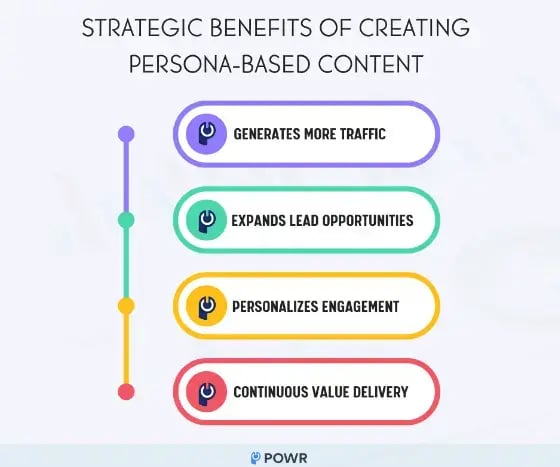Persona-based content strategies focus on creating tailored content for specific audience segments. This approach enhances engagement by addressing the unique needs and preferences of each persona.
Creating content that resonates with your audience is essential for effective marketing. Understanding your target personas allows you to craft messages that speak directly to their interests and pain points. This strategy not only boosts engagement but also improves conversion rates.
By using data-driven insights, you can identify what your audience values most. Tailored content fosters a deeper connection, making your brand more relatable. As digital marketing evolves, adapting to your audience’s needs becomes crucial. Implementing persona-based strategies can significantly enhance your content’s relevance and effectiveness, ultimately driving better results for your business.

Credit: www.linkedin.com
Introduction To Persona-based Content
Persona-based content strategies focus on creating content that speaks directly to specific audiences. This approach helps businesses understand their customers better.
By using data and insights, marketers can develop targeted content. Such content addresses the unique needs and interests of different personas.
| Key Benefits | Description |
|---|---|
| Increased Engagement | Targeted content keeps readers interested and boosts interaction. |
| Higher Conversion Rates | Relevant content leads to more sales and sign-ups. |
| Stronger Brand Loyalty | Understanding customers fosters trust and loyalty over time. |

Credit: blog.powr.io
Creating Buyer Personas
Understanding your audience is key. Use surveys and interviews to gather insights. Social media can also provide valuable data.
Analyzing customer data helps identify patterns. Look for trends in buying habits and preferences. Website analytics can show popular content and user behavior.
Segmenting personas improves targeting. Group customers by demographics, interests, and buying behavior. Create tailored content for each segment to boost engagement.
Crafting Content That Resonates
Creating content that connects with your audience is essential. Matching the tone and style to your audience’s preferences helps build trust. Use simple language for younger audiences and a more professional tone for business clients.
Personalization techniques can make a big difference. Use the audience’s name in emails. Create content based on their interests. Segment your audience for targeted messages. This makes them feel special and valued.
Consider using surveys to gather feedback. This helps understand what the audience really wants. Tailor your content based on their responses. This leads to better engagement and loyalty.
Mapping The Customer Journey
The Awareness Stage is crucial for attracting customers. Use blog posts and social media to educate your audience. Create engaging videos that explain your products or services. This helps build brand recognition and trust.
In the Consideration Stage, offer detailed guides and case studies. Customers seek more information before making a choice. Use webinars to showcase your expertise. This allows potential buyers to see the value of your offerings.
For the Decision Stage, focus on product demos and customer testimonials. This builds confidence in your brand. Offering special promotions can also encourage buyers to take action. Clear calls-to-action should guide them toward making a purchase.
Channel-specific Content Approaches
Social media needs engaging and visual content. Use short videos and eye-catching images. Posts should encourage users to share and comment. Tailor messages to fit different platforms. This helps in reaching more audiences.
Email marketing should feel personal. Use the recipient’s name and interests. Send content based on past behavior. This makes emails feel special and encourages open rates. Offer exclusive deals to keep users engaged.
For the web and mobile, content must be clear and concise. Use simple language and avoid jargon. Ensure that your website loads quickly. Mobile users prefer easy navigation. Content should fit well on all screen sizes.
Measuring Content Effectiveness
Measuring content effectiveness relies on clear Key Performance Indicators (KPIs). These metrics help track how well content performs. Common KPIs include traffic, engagement, and conversion rates. Monitoring these indicators offers valuable insights.
Use analytics tools to collect data. Analyze which content resonates with your target audience. Adapting strategy based on analytics can significantly improve results. This ensures content aligns with audience needs and preferences.
| Key Performance Indicators | Description |
|---|---|
| Traffic | Measures the number of visitors to your content. |
| Engagement | Tracks interactions like comments, shares, and likes. |
| Conversion Rates | Shows the percentage of users taking a desired action. |
Challenges And Solutions In Persona-based Content
Maintaining authenticity in persona-based content is essential. Understanding your audience’s needs helps create genuine connections. Avoid using jargon or complex terms. Simple language resonates better with your audience.
Research your audience to know their interests and problems. Create content that speaks directly to them. Use real stories and examples to build trust. Always stay true to your brand voice.
Regularly gather feedback to improve your content. This shows your audience you care about their opinions. Adapting to their needs keeps your content relevant and engaging.

Credit: fastercapital.com
Case Studies And Success Stories
Many brands successfully use persona-based content strategies. They understand their audience’s needs and preferences. This helps them create relevant content.
Brands that excel:
- Nike: Focuses on athletes’ stories.
- HubSpot: Provides useful tools for marketers.
- Amazon: Offers personalized product recommendations.
These companies show the power of knowing your audience. Creating targeted content improves engagement. Brands should study their audience’s behavior. This leads to better content strategies.
Lessons learned include the importance of research. Brands must analyze their audience. Regularly updating personas keeps content fresh. Always remember to measure success through feedback.
Future Of Persona-based Content Strategy
AI and Machine Learning are changing content strategies. These technologies analyze user data quickly. They help create personalized experiences for each persona. Brands can now understand what users want better.
Emerging trends show that AI-driven tools can predict user behavior. This leads to more effective content creation. Marketers can tailor messages to specific groups. Engaging content increases user interaction and satisfaction.
Automation tools will streamline content distribution. This saves time and resources for marketers. The future will see a blend of creativity and technology. This balance will enhance audience connections.
Frequently Asked Questions
What Are Persona-based Content Strategies?
Persona-based content strategies tailor content to specific audience segments. By understanding your audience’s needs, preferences, and pain points, you can create relevant and engaging content. This approach increases user engagement and improves conversion rates, making your marketing efforts more effective.
How Do I Create A Buyer Persona?
To create a buyer persona, start with research. Analyze demographics, behaviors, and preferences of your target audience. Conduct surveys or interviews to gather insights. Once you have this data, compile it into a detailed profile that represents your ideal customer.
This will guide your content strategy effectively.
Why Use Personas In Content Marketing?
Using personas in content marketing enhances relevance. It helps you understand what your audience values and how they consume content. This targeted approach improves engagement, leading to higher conversion rates. Additionally, it ensures that your content addresses specific pain points, making it more impactful.
What Types Of Personas Should I Consider?
Consider various persona types based on demographics and behavior. Focus on buyer personas, user personas, and marketing personas. Each type serves a different purpose in your strategy. Tailor content to meet the unique needs of each persona for maximum effectiveness.
Conclusion
Effective persona-based content strategies drive engagement and boost conversions. By understanding your audience’s needs and preferences, you can create tailored content that resonates. This approach fosters stronger connections, enhancing brand loyalty. Embrace these strategies to elevate your content marketing efforts and achieve lasting success in a competitive landscape.



